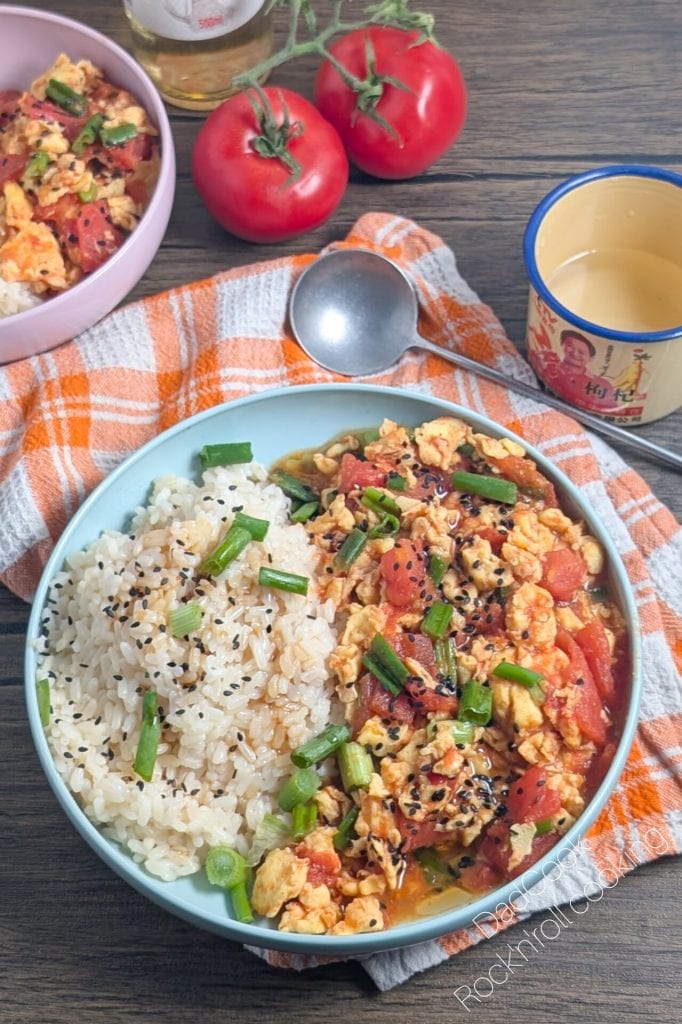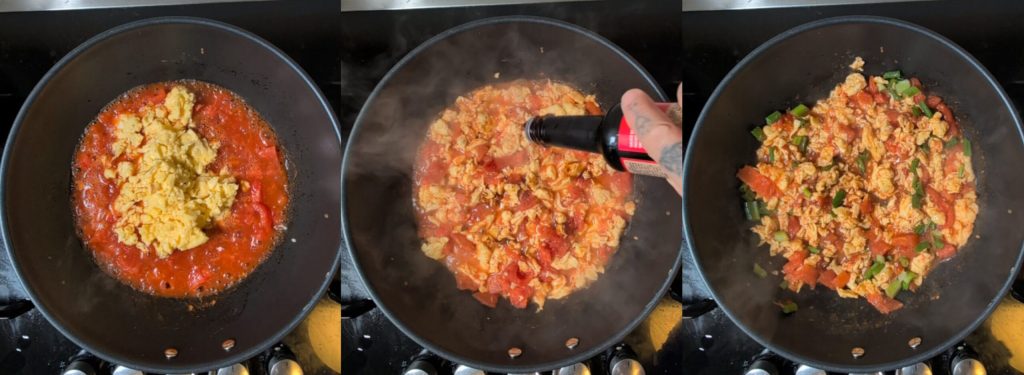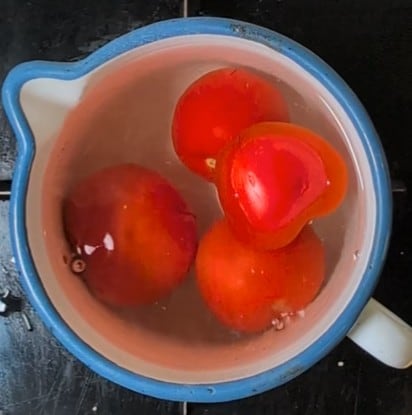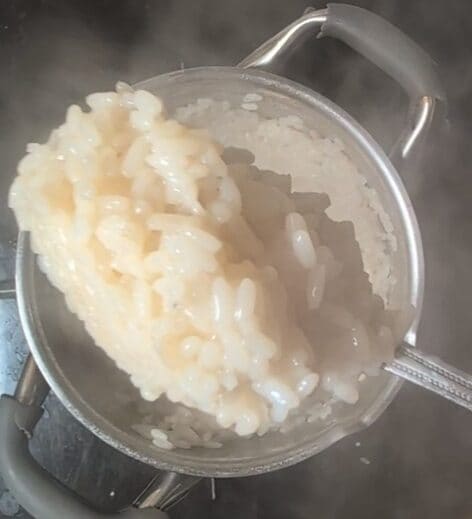番茄炒蛋 (Fānqié chǎo dàn): The Simple Flavor Explosion Conquering the World (and Your Palate!) Forget complex culinary alchemies: today we reveal the secret of one of the most beloved and surprisingly versatile Chinese dishes: Scrambled Eggs with Tomato (番茄炒蛋 – Fānqié chǎo dàn). More than just a simple combination of basic ingredients, this recipe embodies the philosophy of Chinese cuisine in its essence: transforming simplicity into a flavor explosion that caresses the palate and warms the heart.
If you too are among those who seek easy and quick recipes without sacrificing authentic and satisfying taste, get ready to discover a true oriental comfort food that is taking the internet by storm (and for good reason!). While the trend for leek omelets is setting the web on fire, we’re guiding you to discover an equally delicious and incredibly simple alternative: a perfect combination of the juicy sweetness of ripe tomatoes and the enveloping softness of scrambled eggs, all enhanced by a touch of oriental savoriness.
Prepare to immerse yourself in a culinary journey that will take you directly into homes and restaurants across China. Follow our step-by-step recipe, and in just a few minutes, you can enjoy a dish that is not only economical and nutritious but will surprise you with its incredible goodness. Scrambled Eggs with Tomato (番茄炒蛋) is not just a meal: it’s a taste experience that will make you fall in love with the simplicity of true Chinese cuisine.
Put on your apron, the intoxicating aroma is on the way!
- Chinese Braised Pork Belly, Hongshao Rou: the recipe you must try
- Century Egg: a culinary journey into Chinese tradition
- Quick Recipe: Soy Noodles and Ground Meat in Sweet and Sour Sauce
- Beef Noodles in Teriyaki-Style Sauce (easy and quick)
- Rice Dumplings with Shrimp and Vegetables: the Chinese restaurant trick to cooking them perfectly and deliciously.

- Difficulty: Very easy
- Cost: Very economical
- Rest time: 5 Minutes
- Preparation time: 10 Minutes
- Portions: 4
- Cooking methods: Stove, Frying
- Cuisine: Italian
- Seasonality: All seasons, Spring, Summer
- Energy 397.83 (Kcal)
- Carbohydrates 57.71 (g) of which sugars 2.64 (g)
- Proteins 16.59 (g)
- Fat 10.85 (g) of which saturated 3.60 (g)of which unsaturated 7.10 (g)
- Fibers 1.39 (g)
- Sodium 258.25 (mg)
Indicative values for a portion of 410 g processed in an automated way starting from the nutritional information available on the CREA* and FoodData Central** databases. It is not food and / or nutritional advice.
* CREATES Food and Nutrition Research Center: https://www.crea.gov.it/alimenti-e-nutrizione https://www.alimentinutrizione.it ** U.S. Department of Agriculture, Agricultural Research Service. FoodData Central, 2019. https://fdc.nal.usda.gov
Ingredients
Discover the simplicity and goodness of a timeless classic of Chinese cuisine: Scrambled Eggs with Tomato (番茄炒蛋 – Fānqié chǎo dàn)!
A quick, economical, and incredibly tasty recipe, perfect for a light lunch or a quick dinner.
- 1 1/2 cups parboiled rice
- 8 eggs
- 5 tomatoes
- 6 tablespoons vegetable oil
- 3 fresh scallion (Green part)
- 1/4 cup sake (Or white wine)
- 2 tablespoons sesame seeds
- 1 pinch black pepper
- to taste salt
Tools
A Dip into Oriental Flavor Ready in a Flash! Prepare an iconic dish of Chinese cuisine that will win you over with its simplicity and enveloping taste: Scrambled Eggs with Tomato (番茄炒蛋 – Fānqié chǎo dàn)!
Perfect for a quick and tasty dinner, this oriental comfort food is an explosion of freshness and softness. Tools:
- 1 Deep plate Thun
- 1 Chinese chopsticks Frevoitna
- 1 Pan Amazon BASIC
Steps
Follow our simple steps to prepare in no time an authentic 番茄炒蛋 (Fānqié chǎo dàn), the delicious Chinese Scrambled Eggs with Tomato. A quick, nutritious, and flavorful dish, perfect for any occasion!
Prepare the Base and Tomatoes:
Start by boiling water for the parboiled rice and cook it according to the package instructions.
Meanwhile, work on the tomatoes: blanch them quickly in boiling water to ease skin removal.
Once cooled, remove the skin and cut the flesh first into strips and then into cubes.
This preliminary preparation ensures optimal cooking and a pleasant texture of the tomato in the final dish.

Cook the Scrambled Eggs:
In a bowl, vigorously beat the eggs with a pinch of salt and a grind of black pepper.
Heat the vegetable oil in a non-stick pan over medium heat.
Pour the beaten eggs into the pan and cook them, gently scrambling with a spatula.
Move them constantly to achieve a soft consistency without over-drying.
Once cooked but still moist, remove the eggs from the pan and set them aside, keeping them warm.

Saute and Deglaze the Tomato:
In the same pan where you cooked the eggs, add another drizzle of vegetable oil if needed.
Pour in the tomato cubes and strips, and sauté over medium heat, stirring occasionally, until much of the water released by the tomato has evaporated and the sauce has slightly thickened.
At this point, deglaze with sake (or dry white wine), allowing the alcohol to evaporate to enhance the tomato’s flavor.

Combine the Flavors and Add the Final Touch:
Return the scrambled eggs to the pan with the tomato.
Flavor everything with soy sauce, gently stirring to distribute evenly.
Taste and adjust salt if needed, considering the saltiness of the soy sauce.
Let everything flavor for a couple of minutes over low heat, allowing the flavors to meld.
Finally, add only the finely chopped green part of the scallion, gently mix to distribute, and turn off the heat.

Plate and Enjoy: It’s time to enjoy this delight!
Plate the hot parboiled rice in a bowl or plate and serve a generous portion of Scrambled Eggs with Tomato on the side.
Garnish, if desired, with a few more rings of fresh green scallion and a sprinkle of sesame seeds.
Prepare for an explosion of simple yet incredibly satisfying flavors!
Enjoy your meal!

Chinese Scrambled Eggs with Tomato: A Versatile and Resourceful Dish!
You have just prepared a delicious 番茄炒蛋 (Fānqié chǎo dàn)! But how to store it, what variations to try, and what tips to follow for a consistently perfect result? Here’s a section dedicated to making the most of this fantastic recipe.
Storage, Variations, Tips, and Notes:
Storage:
Chinese Scrambled Eggs with Tomato can be stored well in the refrigerator, inside an airtight container, for about 2-3 days. When reheating, we recommend doing so gently in a pan over low heat, possibly adding a tablespoon of water or broth to revive the moisture. Microwave reheating is possible, but it might slightly alter the eggs’ texture.
Variations:
This dish is incredibly versatile and lends itself to various interpretations:
Garlic Addition: Sauté a clove of chopped garlic with the tomato for a more intense flavor.
Chili Pepper: For a spicy touch, add a pinch of chili powder or a piece of fresh chopped chili pepper during the tomato cooking.
Dark Soy Sauce: A small addition of dark soy sauce alongside light soy sauce can give a more intense color and a slightly maltier flavor.
Extra Vegetables: You can enrich the dish by adding other sautéed vegetables with the tomato, such as sliced mushrooms, onions, or diced peppers.
Cheese: Some modern variations include a sprinkle of grated cheese (like Parmesan or Pecorino) at the end of cooking for an extra touch of flavor.
Herbs: Besides scallion, you can experiment with adding fresh chopped parsley or cilantro at the end of cooking.
Tips:
Tomato Quality: Use ripe and juicy tomatoes for better flavor. If out of season, you can opt for good canned peeled tomatoes.
Egg Cooking: Do not overcook the scrambled eggs in the first phase; they should remain soft and moist to not become dry once combined with the tomato.
Flavor Balance: Always taste during cooking and adjust salt and pepper according to your preference. Soy sauce is salty, so be careful with the salt.
Serving: Traditionally served with white rice, this dish is also excellent with sautéed noodles or simply enjoyed alone with a slice of toasted bread.
Notes:
Sake (or white wine) helps to deglaze the tomato flavors and adds a slight acidity that balances the sweetness. If you don’t have it, you can omit it or substitute with a tablespoon of rice vinegar or lemon juice.
The white part of the scallion has a more intense flavor and is often used at the start of cooking to flavor the oil, while the green part, more delicate, is perfect as a fresh garnish at the end of cooking.
Experiment with these variations and tips to personalize your Chinese Scrambled Eggs with Tomato and make it even more your own!

FAQ (Frequently Asked Questions)
番茄炒蛋 (Fānqié chǎo dàn): Answers to All Your Questions!
Do you have any doubts about the preparation, ingredients, or variations of the delicious Chinese Scrambled Eggs with Tomato?
We have gathered the most frequently asked questions to help you create a perfect dish and answer all your curiosities!
Can I prepare this dish in advance?
Scrambled eggs tend to lose their ideal texture if prepared too far in advance and reheated. It is preferable to prepare the dish at the moment to enjoy it at its best. However, you can cut the tomatoes in advance and store them in the refrigerator in an airtight container.

I don’t have sake, can I use something else?
Absolutely! If you don’t have sake, you can replace it with an equal amount of dry white wine. Alternatively, you can omit it entirely or add a teaspoon of rice vinegar or lemon juice for a similar touch of acidity.

Can I use another type of oil instead of vegetable oil?
Yes, you can use other vegetable oils with a high smoke point, such as peanut oil, sunflower oil, or even a light extra virgin olive oil (though the latter might slightly alter the traditional taste).

Do I have to blanch the tomatoes?
Blanching the tomatoes makes it much easier to remove the skin, which improves the texture of the final dish. However, if you prefer, you can skip this step and cut the tomatoes into cubes with the skin on. In this case, cook them a bit longer to soften it.

Can I add other spices?
Certainly! You can experiment by adding a pinch of grated ginger along with garlic (if using it) for a more aromatic flavor, or a dash of monosodium glutamate (MSG) to enhance the umami taste (use in moderation if desired).
How can I make this dish vegetarian (if it’s not already)?
This recipe is inherently vegetarian, as the main ingredients are eggs and tomatoes. Be sure to use vegetable oil for cooking.
Can I freeze Scrambled Eggs with Tomato?
It is not advisable to freeze this dish, as the texture of the eggs and tomatoes could significantly change after thawing, becoming watery and less appetizing. It’s best enjoyed fresh.
What’s the best way to serve the 番茄炒蛋 (Fānqié chǎo dàn)?
Traditionally, it is served hot accompanied by white rice, which perfectly absorbs the flavorful sauce. It’s also great as a side dish or as a filling for Chinese pancakes (cong you bing) or inside a sandwich.

We hope these answers have clarified any doubts! Feel free to experiment and personalize this delicious Chinese recipe. Have fun in the kitchen!

